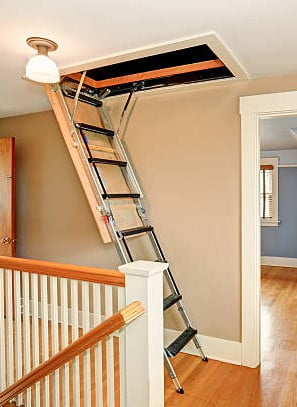 |
| Attic pull-down ladders, also called attic pull-down stairways, are collapsible ladders that are permanently attached to the attic floor. Occupants can use these ladders to access their attics without being required to carry a portable ladder. |
 |
| Common Defects: Homeowners, not professional carpenters, usually install attic pull-down ladders. Evidence of this distinction can be observed in consistently shoddy and dangerous work that rarely meets safety standards. Some of the more common defective conditions observed by inspectors include:Cut bottom cord of structural truss. Often, homeowners will cut through a structural member in the field while installing a pull-down ladder, unknowingly weakening the structure. Structural members should not be modified in the field without an engineer’s approval. Fastened with improper nails or screws. Homeowners often use drywall or deck screws rather than the standard 16d penny nails or ¼” x 3” lag screws. Nails and screws that are intended for other purposes may have reduced shear strength and they may not support pull-down ladders;Fastened with an insufficient number of nails or screws. Manufacturers provide a certain number of nails with instructions that they all be used, and they probably do this for a good reason. Inspectors should be wary of “place nail here” notices that are nowhere near any nails. Lack of insulation. Hatches in many houses (especially older ones) are not likely to be weather-stripped and/or insulated. An uninsulated attic hatch allows air from the attic to flow freely into the home, which may cause the heating or cooling system to run overtime. An attic hatch cover box can be installed to increase energy savings. Loose mounting bolts. This condition is more often caused by age rather than installation, although improper installation will hasten the loosening process. Attic pull-down ladders are cut too short. Stairs should reach the floor. Attic pull-down ladders are cut too long. This causes pressure at the folding hinge, which can cause breakage. Other Issues Compromised fire barrier when installed in the garage. Attic ladder frame is not properly secured to the ceiling opening. Closed ladder is covered with debris, such as blown insulation or roofing material shed during roof work. Inspectors can place a sheet on the floor beneath the ladder to catch whatever debris may fall onto the floor; and Cracked steps. This defect is a problem with wooden ladders. In sliding pull-down ladders, there is a potential for the ladder to slide down quickly without notice. Always pull the ladder down slowly and cautiously. Do not allow children to enter the attic through an attic access. The lanyard attached to the attic stairs should be short enough that children cannot reach it. Parents can also lock the attic ladder so that a key or combination is required to access it. If possible, avoid carrying large loads into the attic. While properly installed stairways may safely support an adult man, they might fail if he is carrying, for instance, a bag full of bowling balls. Such trips can be split up to reduce the weight load.Make sure to have at least a 350 Lb capacity Ladder. Make sure that the ladder opening is at least 22 by 30 inches width with 30 inches of head clearance. If ladder is in a garage it is especially important that it is well sealed to prevent fumes from entering the attic and HVAC system. |
